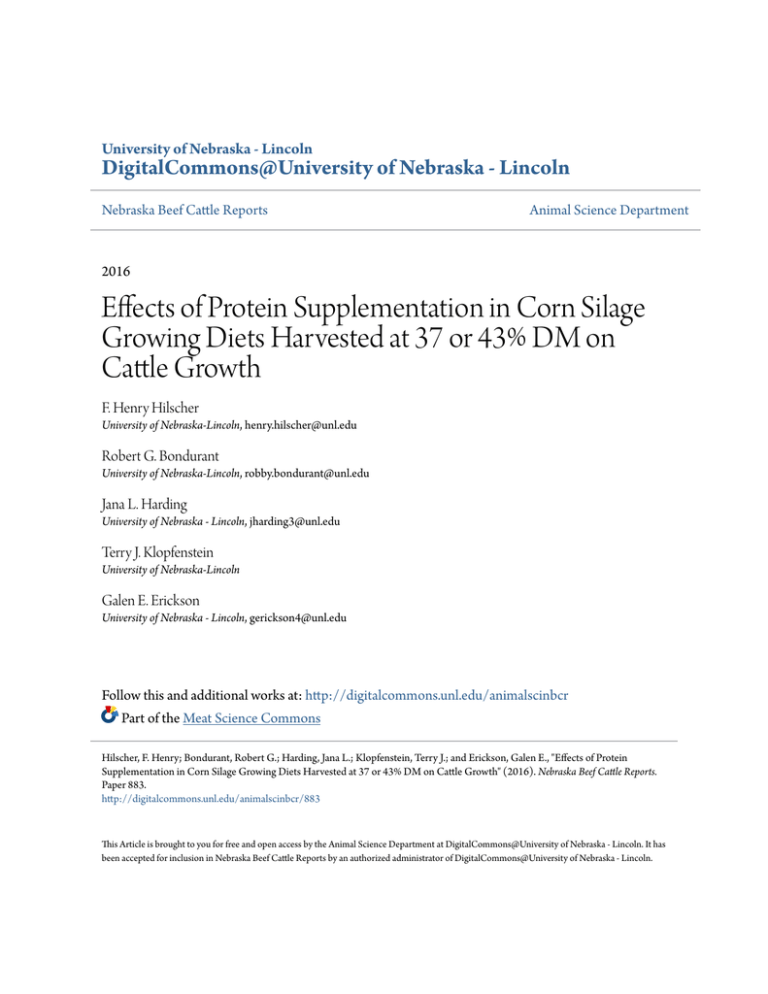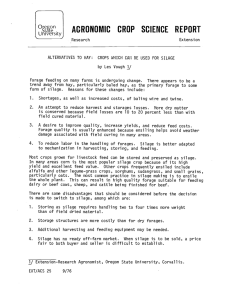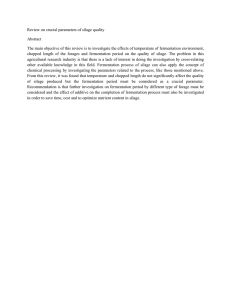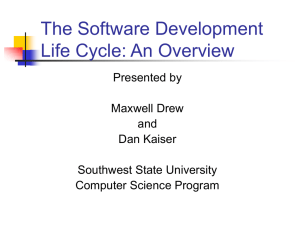
University of Nebraska - Lincoln
DigitalCommons@University of Nebraska - Lincoln
Nebraska Beef Cattle Reports
Animal Science Department
2016
Effects of Protein Supplementation in Corn Silage
Growing Diets Harvested at 37 or 43% DM on
Cattle Growth
F. Henry Hilscher
University of Nebraska-Lincoln, henry.hilscher@unl.edu
Robert G. Bondurant
University of Nebraska-Lincoln, robby.bondurant@unl.edu
Jana L. Harding
University of Nebraska - Lincoln, jharding3@unl.edu
Terry J. Klopfenstein
University of Nebraska-Lincoln
Galen E. Erickson
University of Nebraska - Lincoln, gerickson4@unl.edu
Follow this and additional works at: http://digitalcommons.unl.edu/animalscinbcr
Part of the Meat Science Commons
Hilscher, F. Henry; Bondurant, Robert G.; Harding, Jana L.; Klopfenstein, Terry J.; and Erickson, Galen E., "Effects of Protein
Supplementation in Corn Silage Growing Diets Harvested at 37 or 43% DM on Cattle Growth" (2016). Nebraska Beef Cattle Reports.
Paper 883.
http://digitalcommons.unl.edu/animalscinbcr/883
This Article is brought to you for free and open access by the Animal Science Department at DigitalCommons@University of Nebraska - Lincoln. It has
been accepted for inclusion in Nebraska Beef Cattle Reports by an authorized administrator of DigitalCommons@University of Nebraska - Lincoln.
Effects of Protein Supplementation in Corn Silage Growing
Diets Harvested at 37 or 43% DM on Cattle Growth
F. Henry Hilscher, Robert G. Bondurant, Jana L. Harding, Terry J. Klopfenstein, and Galen E. Erickson
Summary
A growing study evaluated the effects of
harvesting drier corn silage and response to
rumen undegradable protein (RUP) supplementation. Corn silage was harvested at 37
or 43% DM from the same fields and protein
supplement (high in RUP) was provided
at 0.0, 2.5, 5.0, 7.5 or 10.0% of diet DM.
Ending BW and ADG were decreased, while
F:G was increased, when steers were fed 43%
DM silage compared to 37% DM silage (88%
silage inclusion). Increasing supplemental
RUP in the diet increased ending BW, DMI,
and ADG linearly, and decreased F:G linearly. Drier silage had less energy for growing
steers while supplemental RUP improved
gain and efficiency in silage growing diets.
Introduction
Feeding greater inclusions of corn silage
during times of increased corn prices can
be an economical alternative compared to
corn, although ADG and F:G are not as
favorable. Feeding corn silage allows cattle
feeders to take advantage of the entire corn
plant at a time of maximum quality and
tonnage as well as secure substantial quantities of roughage/grain inventory (2013
Nebraska Beef Cattle Report, pp. 74–75).
Plot work suggests that as corn harvest is
delayed to black layer formation, corn and
whole plant yield is maximized with little
effect on nutritive quality as measured in
the lab (2013 Nebraska Beef Cattle Report,
pp. 42–43; 2016 Nebraska Beef Cattle Report, pp. 79–80).
Corn silage typically contains 6.5 to
8.5% CP, most of which is in the form of
RDP and is utilized for microbial protein
synthesis. Our hypothesis was that very
little protein from corn silage escapes the
rumen (i.e., RUP) and previous estimates of
RUP of silages are likely incorrect. Inadequate supplemental RUP could result in inadequately meeting metabolizable protein
requirements (NRC, 2000). Thus, source
and amount of supplemental protein are
important factors affecting growth because
supplemental protein provides a significant amount of the total dietary protein
(2014 Professional Animal Scientist, pp.
327–332). Therefore, the objectives of this
experiment were to determine the effects
of delaying corn silage harvest on growing
steer performance while determining RUP
response when growing cattle are fed corn
silage-based diets.
corn silage (9/4/2014), and delayed two
wks coinciding with black layer formation
for the 43% DM corn silage (9/16/14).
Corn silage was harvested in 4 replications
within field and green chop samples were
taken for DM determination on a Koster
tester prior to bagging. Additionally, high
moisture corn and dry corn yield strips
were harvested within the same field on
9/18/14 and 11/4/14, respectively. Both
37% DM and 43% DM silages were stored
in sealed AgBags and after 28 d, silage was
sampled for fermentation analysis and
DM samples were collected weekly during
feedout (Table 1).
A 78-d growing study was conducted
using crossbred steers (n = 60; initial BW
= 597 lb; SD = 70 lb) that were individually fed using the Calan gate system.
Trial initiation occurred after 4 months of
corn silage harvest. Five days before trial
initiation, cattle were limit-fed a common
diet of 50% alfalfa hay and 50% Sweet Bran
(Cargill, Blair, Neb) at 2% of BW to reduce
variation in gut fill and then weighed on
Procedure
Corn silage harvest data were previously presented (2016 Beef Cattle Report pp.
146–48). Corn silage was harvested at the
Agricultural Research and Development
Center (ARDC) near Mead, Neb. Harvest
DM was targeted to mimic traditional corn silage harvest at 37% DM or a
delayed harvest at 43% DM. Corn silage
harvest was initiated when the field was at
approximately ¾ milkline for the 37% DM
Table 1. Nutrient and fermentation analysis of 37 and 43 % DM silage
Item
DMb
CP
37 DM
43 DM
Mean
C.V.a
Mean
C.V.a
37.3
(3.2)
42.7
(3.9)
7.51
(3.6)
7.50
(1.2)
NDF, %
31.55
(17.5)
28.88
(5.7)
ADF, %
21.38
(15.8)
18.63
(17.9)
Starch, %
35.4
(16.7)
40.8
(5.0)
Sugar, %
2.6
(19.6)
2.5
(8.7)
pH
3.88
(1.3)
3.85
(1.5)
Lactic acid, %
3.11
(26.9)
4.14
(28.1)
Acetic acid, %
3.98
(21.5)
2.81
(27.1)
Propionic acid, %
0.51
(26.8)
0.28
(54.3)
< 0.01
(0.0)
< 0.01
(0.0)
7.61
(10.5)
7.22
(3.3)
Butyric acid, %
Total acids, %
a
C.V. = coefficient of variation and is calculated by dividing the standard deviation by the mean and is expressed as a
percentage.
DM was calculated using weekly samples and oven dried for 48 h at 600 C.
Note: All other samples are based on monthly composites, and analyzed at Dairyland Labs (St. Cloud, MN) and Ward Labs
(Kearney, NE).
b
© The Board Regents of the University of
Nebraska. All rights reserved.
2016 Nebraska Beef Cattle Report · 49
3 consecutive days, with the average used
as initial BW. The common growing diet
consisted of either 37% DM or 43% DM
corn silage at 88% of diet DM, and treatments consisted of top dressing a blend
of 0/100, 25/75, 50/50, 75/25, or 100/0
combination of a RDP and RUP supplement (Table 2). This combination allowed
for 0, 2.5, 5.0, 7.5, or 10 % in the form of
SoyPass (50% CP; 75% RUP as % of CP)
and Empyreal (Cargill, Blair, Neb; 75% CP;
65% RUP as % of CP) in the growing diet.
The supplement included Rumensin and
was formulated to provided 200 mg/steer
daily. Steers were stratified by day-1 and
day 0 BW, and assigned randomly to 1 of
10 treatments (Table 2), arranged in a 2 × 5
factorial arrangement with 5 to 8 steers per
level of RUP supplementation (n = 8 for 0%
RUP; n = 5 for 2.5% and 5% RUP; n = 6 for
7.5% and 10.0% RUP treatments). With a
limited number of bunks, a greater number
of animals were used at 0% RUP inclusion
to establish the intercept for response to
supplemental RUP. In addition, a greater
number of steers were in the7.5% and 10%
supplemental RUP source treatments to
establish the maximum gain response as it
was hypothesized the metabolizable protein
needs would be met. Steers were implanted with Ralgro on d 0. Steers were fed ad
libitum once daily at 8 am. Feed refusals
were collected weekly, weighed, and then
dried in a 60°C forced air oven for 48 hours
to calculate an accurate DMI for individual
steers. At the conclusion of the study, steers
were limit-fed the same diet as prior to the
start of the trial at 2% of BW for 5 days.
Weights were collected for 3 consecutive
days and averaged to determine an accurate
ending BW.
Data were analyzed using the mixed
procedure of SAS as a randomized block
design in a 2 × 5 factorial arrangement
testing for linear and quadratic interactions
between silage DM and RUP supplementation with steer serving as the experimental
unit and weight block as a fixed effect. If
no interactions were detected, the main
effects of silage DM and supplemental RUP
were evaluated. To evaluate RUP supplementation, linear and quadratic contrasts
were developed to determine the effect of
increasing RUP inclusion. Significance was
declared at P ≤ 0.05.
50 · 2016 Nebraska Beef Cattle Report
Table 2. Diet composition (% of diet DM) fed to individually-fed growing steers for 78 d
Treatmenta
Ingredient
37% DM
43% corn silage
0.0%
2.5%
5.0%
7.5%
10.0%
0.0%
2.5%
5.0%
7.5%
37% DM corn
silage
88.0
88.0
88.0
88.0
43% DM corn
silage
—
—
—
RDP
supplementb
12.0
9.0
RUP
supplementc
0.0
3.0
10.0%
88.0
—
—
—
—
—
—
—
88.0
88.0
88.0
88.0
88.0
6.0
3.0
0.0
12.0
9.0
6.0
3.0
0.0
6.0
9.0
12.0
0.0
3.0
6.0
9.0
12.0
a
Treatments: Diets contained 88% of either 37 or 43% DM corn silage and formulated to contain 0, 2.5, 5.0, 7.5 or 10.0% RUP.
RDP supplement: was formulated for a target inclusion level of 12% and contained 9.35% soybean hulls, 1.2% urea, 0.45%
dicalcium phosphorus, 0.40% salt, 0.3% tallow, 0.21% limestone, 0.05% trace minerals, 0.015% Vitamin A-D-E as a % of total
diet DM. Formulated to provide 200 mg/steer daily of Rumensin (Elanco, Greenfield, IN :DM basis)
c
RUP supplement: was formulated for a target inclusion level of 12% and contained 6.0% SoyPass, 4.0% Empyreal (Cargill
branded corn gluten meal product, Blair, Neb), 0.42% soybean hulls, 0.3% urea, 0.2% dicalcium phosphorus, 0.30% Salt, 0.3%
tallow, 0.40% limestone, 0.05% trace minerals, 0.015% Vitamin A-D-E as a % of total diet DM. Formulated to provide 200 mg/
steer daily of Rumensin (% of diet DM)
b
Table 3. Effects of delayed silage harvest on growing steer performance
Treatmentsa
Item
37% DM
SEM
P-value
43% DM
Initial BW, lb
597
597
3.8
0.92
Ending BW, lb
846
826
6.7
0.04
0.3
0.93
DMI, lb/d
18.0
17.9
ADG, lb
3.19
2.93
0.07
0.01
Feed:Gainb
5.63
6.11
—
< 0.01
a
Treatments: steers were fed 88% of either 37 or 43% DM corn silage.
Analyzed as gain:feed, the reciprocal of F:G.
b
Table 4. The effects of increased inclusion of RUP in silage based
growing diets on performance of cross bred steers
Treatmentsa
Variable
Lin.
Quad.
0.0%
2.5%
5.0%
7.5%
10.0%
Initial BW, lb
595
597
597
596
600
5.2
0.98
0.60
Ending BW,
lb
791
824
855
842
868
9.1
< 0.01
0.88
0.5
0.05
0.84
DMI, lb/d
a
SEM
16.9
18.3
18.9
17.4
18.4
ADG, lb
2.51
2.91
3.31
3.15
3.43
0.09
< 0.01
0.82
F:Gb
6.74
6.26
5.71
5.52
5.35
—
< 0.01
0.57
Treatments: steers were fed 88% corn silage and a combination of RDP and RUP supplements to achieve either 0, 2.5, 5.0, 7.5
or 10 % RUP in the final diet.
b
Analyzed as gain:feed, the reciprocal of F:G.
Results
There were no linear (P ≥ 0.33) or
quadratic (P ≥ 0.36) interactions between
corn silage DM and RUP supplementation
for growing performance, therefore main
effects will be discussed. As DM of corn
silage increased from 37 to 43% there was
a significant decrease (P = 0.04) in ending
BW (Table 3). There was no difference (P =
0.93) in DMI between 37 or 43% DM corn
silage, and ADG was reduced (P = 0.01)
as DM of silage increased, which led to a
significant increase (P < 0.01) in F:G.
As supplemental RUP sources in the
growing diet increased from 0 to 10%,
ending BW increased linearly (P < 0.01),
with steers receiving 10% RUP sources
having the heaviest ending BW and steers
receiving 0% RUP having the lowest ending
BW (Table 4). There was a linear increase
(P = 0.05) in DMI as RUP inclusion was
increased in the growing diet. Daily gain
was improved as RUP inclusion increased
in the growing diet, with ADG increasing
(P < 0.01) linearly from 0 to 10% RUP
inclusion. With both an increase in DMI
and ADG, F:G decreased (P < 0.01) linearly
as RUP inclusion increased. This indicates
that increasing RUP in silage growing diets
allowed for increased gains while increasing efficiency of gain.
Feeding silage in growing diets at 88%
of diet DM indicates that 37% DM silage
would result in greater ADG and lower F:G
compared to 43% corn silage. Increasing
the amount of RUP in silage growing diets
resulted in linear increases in ending BW,
DMI, ADG, and F:G. These results indicate
that the addition of RUP into silage diets
will improve performance by supplying
more metabolizable protein. While the
main effect of RUP inclusion was linear,
the response is diminishing with increasing
RUP. Supplementing 10% RUP may be insufficient to meet the metabolizable protein
requirements and even greater inclusions
may improve ADG and F:G further.
F. Henry Hilscher, graduate student
Robert G. Bondurant, research technician
Jana L. Harding, research technician
Terry J. Klopfenstein, professor, Animal
Science University of Nebraska, Lincoln
Neb.
Galen E. Erickson, professor, Animal
Science
2016 Nebraska Beef Cattle Report · 51





